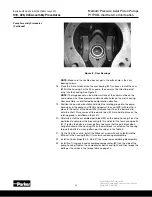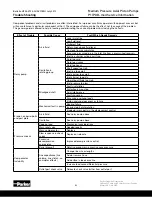
Parker Hannifin Corporation
Hydraulic Pump and Power Systems Division
Marysville, Ohio USA
Bulletin HY28-2708-02/SVC/EN | July 2019
Medium Pressure Axial Piston Pumps
P1/PD B-mod Service Information
55
P1/PD Performance Test Pass/Fail Specifications
Condition
018
028
045
060
075
085
100
140
Test Speed (rpm)
1800 (For All)
Minimum outlet flow (L/min) at minimum pressure (500 psi)
30.7 46.9 77.2
102
129
148
170
239
Maximum case leakage (L/min) when compensated at 280 bar
5.7
7.6
11
13
15
16
20
23
Maximum input torque (Nm) when compensated at 280 bar
40
40
48
39
58
62
68
91
Minimum outlet flow (L/min) at 260 bar with compensator setting at
280 bar
28.4 44.7 72.7
100
123
143
166
233
Allowable load sense flow (L/min) variation from 50 to 260 bar
21.2 30.2 45.5
77
105
105
101
101
• Read and understand the installation and start-up manual
HY28-2709-02/P1/EN.
• Identify components and their function.
• Visually inspect components and lines for possible damage.
• Ensure that all necessary ports are properly connected.
• Check reservoir for cleanliness. Drain and clean as required.
• Check fluid level and fill as required with filtered fluid to a minimum
ISO cleanliness level of 20/18/14.
• Fill pump case with clean oil prior to starting.
• If pump is mounted vertically with the shaft up, bleed the air out the D1
drain port located near the mounting flange.
• Check alignment of drive.
• Check oil cooler and activate it, if included in circuit. Check fluid temperature.
• Reduce pressure settings of compensator and relief valve. Make sure accurate
pressure readings can be made at appropriate places.
• If solenoids in system, check for actuation.
• Jog the pump drive. Check for proper shaft rotation. Make sure pump fills
properly.
• Start the pump drive.
• Bleed system of air. Recheck fluid level.
• Cycle unloaded machine at low pressure and observe actuation
(at low speed, if possible).
• Increase pressure settings gradually in steps. Check for leaks in all lines
especially in pump and motor inlet lines.
• Make correct pressure adjustments.
• Gradually increase speed. Be alert for trouble as indicated by changes in
sounds, system shocks, and air in fluid.
• Equipment is operational.
Startup Procedure for
New Installations
Test Criteria & Start-up Procedures






































